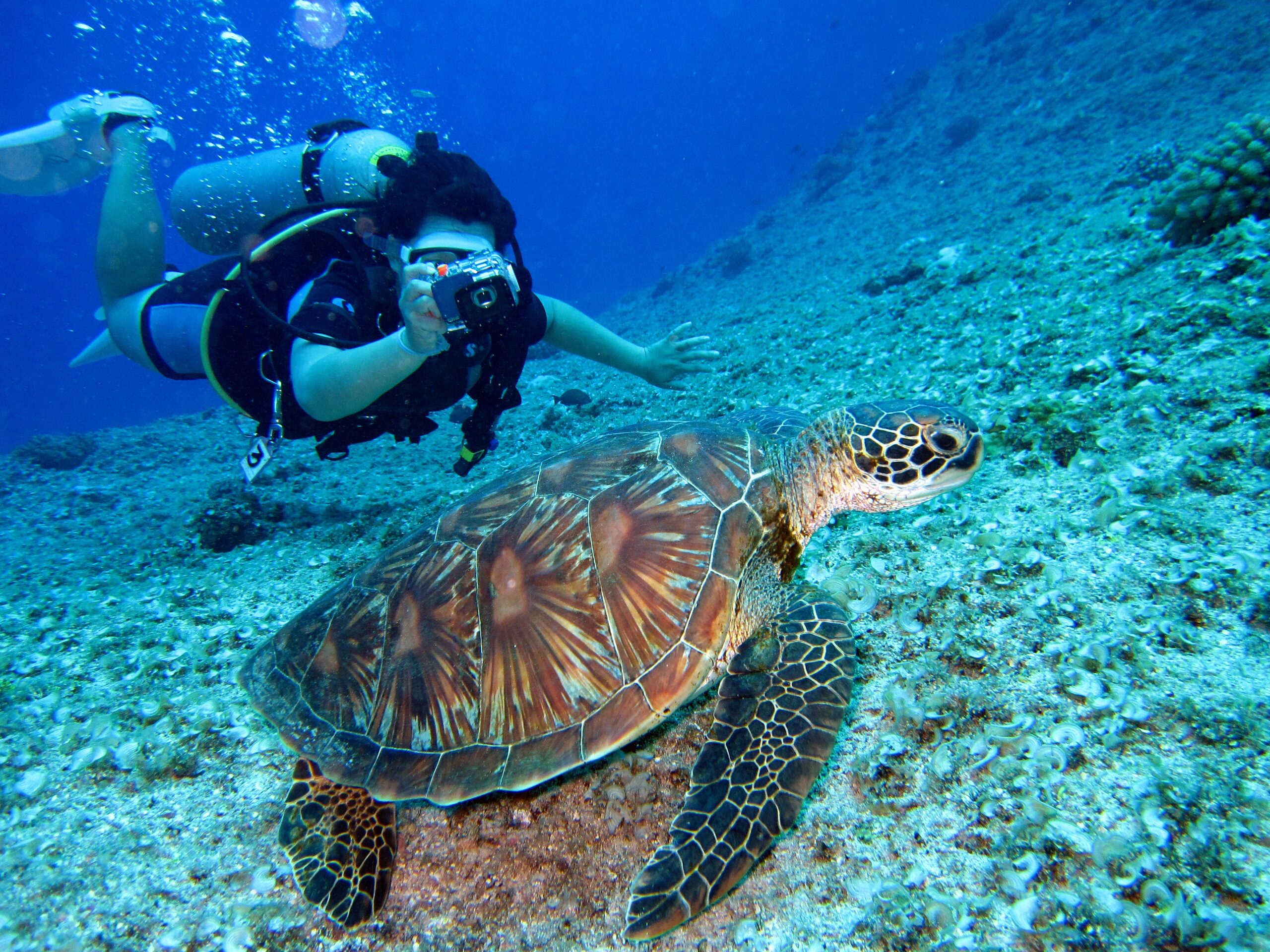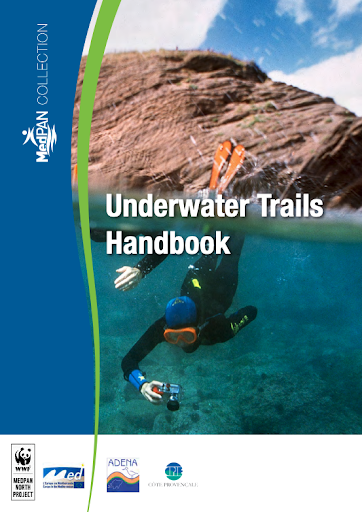 MANAGEMENT TOOL
MANAGEMENT TOOL
Underwater Trails Handbook
Profile by ENI CBC MED ENSERESTO WHOM IS ADDRESSED?
Local authorities, managers of coastal environment, Marine Protected Area (MPA) managers, public authorities, public authorities (MSP)THEME
Beach management, MPA managementKEYWORDS
Awareness raising, management, management plan, recreational area, tourism, Underwater trails, water management
WHAT PROBLEM WOULD THIS SOLVE?
Underwater trails have swiftly gained recognition as a practical and effective tool to educate and raise public awareness on the environment in MPAs. An underwater trail is a concrete example of action taken for the sustainable development of a territory. It is a multi-purpose instrument for land-use management and environmental conservation, environmental education and awareness-raising, promoting a quality recreational nature area, developing an economic resource and responding to social needs such as access to water and discovery.
Aim of the tool
This handbook proposes a framework to develop the activity and organisation of underwater trails as tools for managing the territory. It is the Mediterranean version of the “Methodological and Technical Guide to Underwater Trails” published by Atelier Bleu in 2008.
Main objectives
The Handbook is a methodological and technical reference document for the creation and management of underwater trails. Its specific objectives are to inform and train local managers in the concept of underwater trails and their role in addressing pressures on Mediterranean ecosystems, and to guide them on how to design trails considering legal, organisational, economic and financial aspects.


WHAT IS NEEDED FOR IMPLEMENTATION?
Technological infrastructure
Some technological tools may be necessary for education and awareness raising, such as FM radio snorkels with transmitters on the beach, emitting buoys with an FM radio snorkel, ready-to-use cameras and marking buoys at the site and for the users.
Training
The appropriate training of operators involved in running underwater trails is fundamental for its successful implementation. Existing laws and regulations may require staff to have certain qualifications and skills-specific training in environmental, biodiversity, educational and safety aspects. Moreover, the job of an underwater trail guide requires specific expertise that cannot be found in a traditional training manual, although in France, some local authorities provide training without certification.
Investment
The set-up and running of underwater trails requires investments in infrastructure and start-up as well as user equipment and educational materials, which will vary in amount depending on the site’s features, the manager’s objectives and the available resources (e.g. premises, buoy system). It also requires that operating costs are in place to run, maintain and promote the activity.
Underwater trails generate market and/or non-market income and benefits to the local population, tourists, professionals and institutional stakeholders.

HOW TO USE IT?
Concept
This Handbook is a manual to help local managers and authorities design and implement underwater trails. It addresses the following aspects:
- Definitions of underwater trails and criteria to characterise and recognise the various existing types;
- Their role in addressing existing pressures on Mediterranean ecosystems;
- The regulatory aspects to consider before designing an underwater trail;
- The educational aspects and methods;
- How to design an underwater trail – including identification of the site, target groups, partners, organisation, necessary resources and cost; and
- The economic approach, including the various business models that can be considered.
Pilot areas
The concept first emerged among French marine protected areas around the 2000s. Since then, it has been applied to several sites along the French coasts.
Recommended timeline of Implementation
Underwater trails can be included in the existing management plan of an MPA or local coastal/marine area. They should be developed following a step-by-step approach:
- Definition of the project content and targets;
- Identification of the institutional partners and other sea users to involve;
- Analysis and choice of the site;
- Choice of the type of trail (guided-unguided), organising entity, components of the activity, and identification of means (staff, user facilities, equipment); and
- Monitoring the impact of the underwater trail activity.

WHAT CHALLENGES MAY ARISE?
While designing and implementing underwater trails, organisers should take into account several aspects, including the need to respect marine life, monitor the impact of visits on the area, the link with the territory and cohabitation with other sea uses and users, followed by the training of operators.
Risks related to the type of activity, the environment in which it takes place and other users of the environment, should also be taken into account. In this regard, the Handbook proposes a list of key factors that should be considered to properly address these risks.
Finally, advantages and drawbacks of the proposed types of underwater trails (free access or guided), the means used for the equipping phase and the educational tool proposed, are detailed in the dedicated chapters of the Handbook

WHAT ARE THE EXPECTED RESULTS?
Quantitative results
By applying this tool, it is expected that coastal and marine managers and local authorities plan, develop and implement underwater trails in their territory, which will enhance ecosystem protection, awareness raising and education.
Key deliverables
Key deliverables are knowledge and know-how for the creation and management of underwater trails.
Transfer potential
Underwater trails can be implemented to foster sustainable development at a local level of the marine and coastal environment throughout the Mediterranean. The aim of this Handbook is exactly to encourage the transfer of this tool across all Mediterranean countries. water trails generate market and/or non-market income and benefits to the local population, tourists, professionals and institutional
stakeholders.
KEY INFORMATION
- Almost 20 entities involved in environmental education currently organise underwater trails in the French Mediterranean: two-thirds are local authorities or public institutions and the others are associations, working mainly in partnership with an environmental management organisation.
- About 15,500 people every summer do the Peyrefite underwater trail in the Cerbère Banyuls nature reserve, Easter Pyrenees.
- Being accessible to local populations, an underwater trail can be a concrete tool for securing stakeholder involvement in a project to create a marine protected area. For existing marine protected areas, an underwater trail is naturally in line with the objective of managing visits to the site.

For further information
The MedPAN North project was a transnational European project with the general aim of improving management effectiveness of marine protected areas in the Northern Mediterranean. It was conducted under the stewardship of the MedPAN network and was coordinated by WWF-France. It involved 12 partners from 6 European countries bordering the Mediterranean : Spain, France, Greece, Italy, Malta and Slovenia. The project was co-funded by the European Regional Development Fund through the Med Programme, with a budget of €2.38 million. The project ran between July 2010 and June 2013.
Contact: medpan@medpan.org
Citation:
Baude J.L., Blouet S., Dupuy de la Grandrive R., Jourdan E., Piante C. (2012). Underwater Trails Handbook. MedPAN North Project. WWF-France. 80 pages.
Links of interest:
Partners:
- ACCOBAMS – Agreement on the Conservation of Cetaceans in the
- Black Sea Mediterranean Sea and Contigous Atlantic Area
- ACG – Association de la Continuité des Générations
- AGIR Association
- APAL – Coastal Protection and Development Agency
- Blue World Institute of Marine Research and Conservation
- Cetacean Studies Center
- Columbares association
- Conservatoire du littoral – International Unit
- DMAD – Marine Mammals Research Association
- Eco-ocean
- Enalia Physis Environmental Research Centre
- Environment and Resources Authority (ERA)
- FEDERPARCHI – Italian Federation of Natural Parks and Reserves
- French Biodiversity Office
- Fundacion Biodiversidad
- General Fisheries Commission for the Mediterranean (GFCM)
- General Secretariat of Fisheries – Ministry of Agriculture, Fisheries and Food
- Grouper Study Group
- INCA – Institute for Nature Conservation in Albania
- IUCN – International Union for Conservation of Nature –
- Mediterranean Center for Cooperation
- Interdisciplinary Study Center Gaiola in charge of the Gaiola Underwater Park
- MEDCEM – Mediterranean Center for Environmental Monitoring
- Marevivo
- Marine Explorers Society – 20000 leagues
- Marine Life Conservation Society
- Mediterranean Conservation Society (akdeniz koruma dernegi)
- Mediterranean Small Islands Initiative
- Medwet
- Ministry of Agriculture, Fisheries, Rural development and Water and
- Forests – department of Water and Forests
- Ministry of Environment
- Miraceti
- Morigenos – Slovenian Marine Mammals Society
- Planète Mer
- RODPAL – Network of NGOs in the National Park of Al Hoceima
- Royal Albanian Foundation
- SAD – Underwater Research Society
- SPA/RAC – Specially Protected Areas Regional Activity Centre
- Septentrion Environnement
- Sharklab ADRIA – Centre for marine and freshwater biology
- Society for the Protection of Nature in Lebanon
- Sunce – Association for Nature, Environment and Sustainable Development
- TUDAV – Turkish Marine Research Foundation
- Tour du Valat
- WWF Greece
- WWF Mediterranean Programme Office
- “DelTA” association
- “Le Dauphin” association
- “Notre Grand Bleu” association
- “Posidonia Center for Development and Resources” NGO






